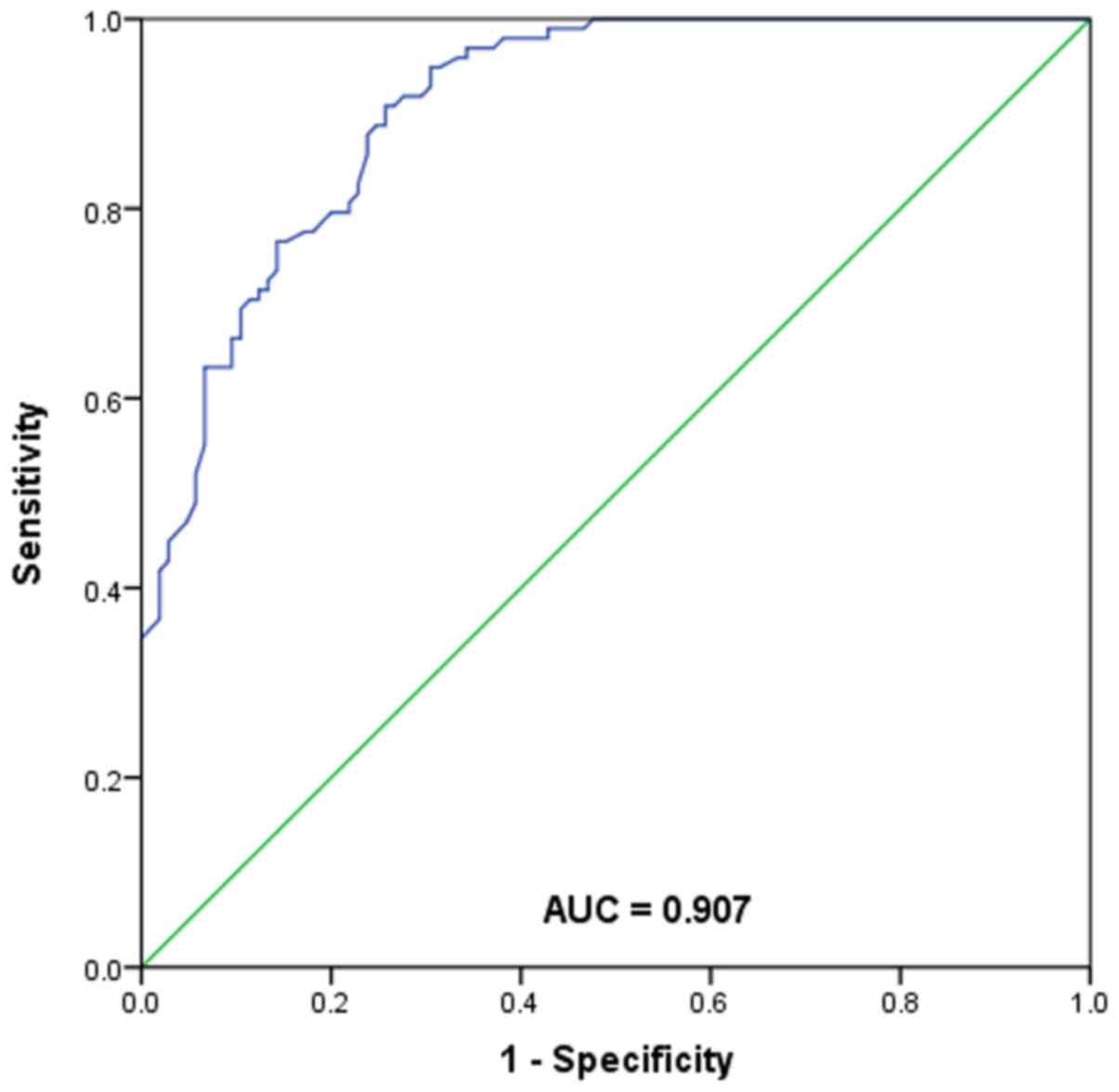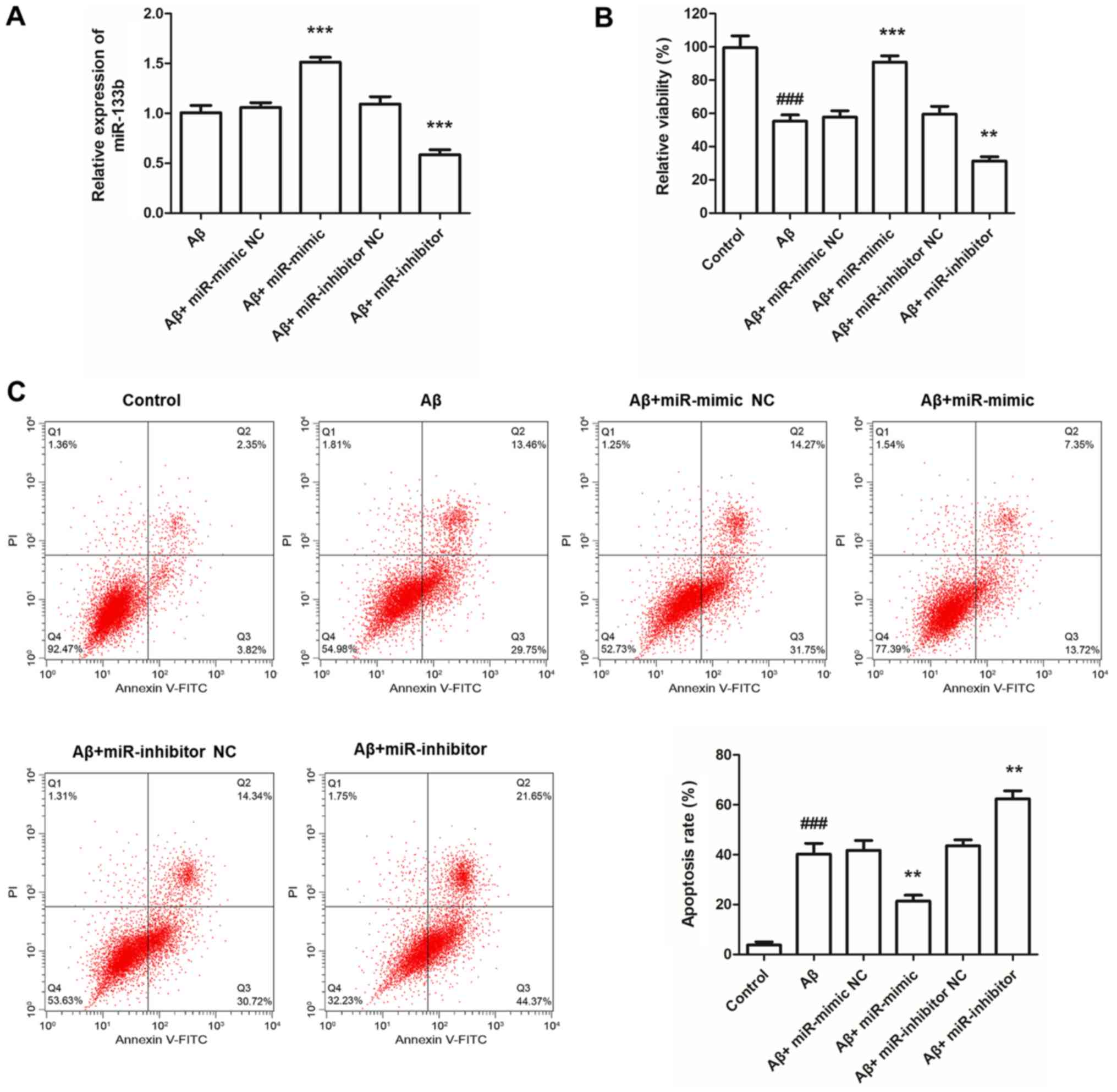|
1
|
Balin BJ and Hudson AP: Etiology and
pathogenesis of late-onset Alzheimer's disease. Curr Allergy Asthma
Rep. 14:4172014. View Article : Google Scholar : PubMed/NCBI
|
|
2
|
Gu QF, Yu JZ, Wu H, Li YH, Liu CY, Feng L,
Zhang GX, Xiao BG and Ma CG: Therapeutic effect of Rho kinase
inhibitor FSD-C10 in a mouse model of Alzheimer's disease. Exp Ther
Med. 16:3929–3938. 2018.PubMed/NCBI
|
|
3
|
Alzheimer's Association National Plan
Milestone Workgroup, Fargo KN, Aisen P, Albert M, Au R, Corrada MM,
DeKosky S, Drachman D, Fillit H, Gitlin L, et al: 2014 report on
the milestones for the US national plan to address Alzheimer's
disease. Alzheimers Dement 10 (5 Suppl). S430–S452. 2014.
|
|
4
|
Mayeux R and Stern Y: Epidemiology of
Alzheimer disease. Cold Spring Harb Perspect Med. 2(pii):
a0062392012.PubMed/NCBI
|
|
5
|
Tan MS, Yu JT and Tan L: Bridging
integrator 1 (BIN1): Form, function, and Alzheimer's disease.
Trends Mol Med. 19:594–603. 2013. View Article : Google Scholar : PubMed/NCBI
|
|
6
|
Bekris LM, Yu CE, Bird TD and Tsuang DW:
Genetics of Alzheimer disease. J Geriatr Psychiatry Neurol.
23:213–227. 2010. View Article : Google Scholar : PubMed/NCBI
|
|
7
|
Paul S: Integration of miRNA and mRNA
expression data for understanding etiology of gynecologic cancers.
Methods Mol Biol 1912. 323–338. 2019. View Article : Google Scholar
|
|
8
|
Huang X, Liang M, Dittmar R and Wang L:
Extracellular microRNAs in urologic malignancies: chances and
challenges. Int J Mol Sci. 14:14785–14799. 2013. View Article : Google Scholar : PubMed/NCBI
|
|
9
|
Kumar S, Vijayan M and Reddy PH:
MicroRNA-455-3p as a potential peripheral biomarker for Alzheimer's
disease. Hum Mol Genet. 26:3808–3822. 2017. View Article : Google Scholar : PubMed/NCBI
|
|
10
|
Hong H, Li Y and Su B: Identification of
circulating miR-125b as a potential biomarker of Alzheimer's
disease in APP/PS1 transgenic mouse. J Alzheimers Dis.
59:1449–1458. 2017. View Article : Google Scholar : PubMed/NCBI
|
|
11
|
Tao J, Wu D, Xu B, Qian W, Li P, Lu Q, Yin
C and Zhang W: microRNA-133 inhibits cell proliferation, migration
and invasion in prostate cancer cells by targeting the epidermal
growth factor receptor. Oncol Rep. 27:1967–1975. 2012.PubMed/NCBI
|
|
12
|
Kim J, Inoue K, Ishii J, Vanti WB, Voronov
SV, Murchison E, Hannon G and Abeliovich A: A MicroRNA feedback
circuit in midbrain dopamine neurons. Science. 317:1220–1224. 2007.
View Article : Google Scholar : PubMed/NCBI
|
|
13
|
Goedert M: NEURODEGENERATION. Alzheimer's
and Parkinson's diseases: The prion concept in relation to
assembled Aβ, tau, and α-synuclein. Science. 349:12555552015.
View Article : Google Scholar : PubMed/NCBI
|
|
14
|
Zhao N, Jin L, Fei G, Zheng Z and Zhong C:
Serum microRNA-133b is associated with low ceruloplasmin levels in
Parkinson's disease. Parkinsonism Relat Disord. 20:1177–1180. 2014.
View Article : Google Scholar : PubMed/NCBI
|
|
15
|
Zhang X, Yang R, Hu BL, Lu P, Zhou LL, He
ZY, Wu HM and Zhu JH: Reduced circulating levels of miR-433 and
miR-133b are potential biomarkers for Parkinson's disease. Front
Cell Neurosci. 11:1702017. View Article : Google Scholar : PubMed/NCBI
|
|
16
|
Niu M, Xu R, Wang J, Hou B and Xie A:
MiR-133b ameliorates axon degeneration induced by MPP(+) via
targeting RhoA. Neuroscience. 325:39–49. 2016. View Article : Google Scholar : PubMed/NCBI
|
|
17
|
Igawa S, Ryuge S, Ichinoe M, Nakashima H,
Otani S, Nakahara Y, Fukui T, Sasaki J, Kubota M, Katagiri M, et
al: Impact of EGFR-tyrosine kinase inhibitors on postoperative
recurrent non-small-cell lung cancer harboring EGFR mutations.
Oncol Res Treat. 40:7–13. 2017. View Article : Google Scholar : PubMed/NCBI
|
|
18
|
Tanaka T, Kaida T, Yokoi K, Ishii S,
Nishizawa N, Kawamata H, Katoh H, Sato T, Nakamura T, Watanabe M
and Yamashita K: Critical relevance of genomic gains of
PRL-3/EGFR/c-myc pathway genes in liver metastasis of colorectal
cancer. Oncol Lett. 17:1257–1266. 2019.PubMed/NCBI
|
|
19
|
Guo N, Zhao Y, Zhang W, Li S and Yu J:
MicroRNA-133a downregulated EGFR expression in human non-small cell
lung cancer cells via AKT/ERK signaling. Oncol Lett. 16:6045–6050.
2018.PubMed/NCBI
|
|
20
|
Bruban J, Voloudakis G, Huang Q, Kajiwara
Y, Al Rahim M, Yoon Y, Shioi J, Gama Sosa MA, Shao Z,
Georgakopoulos A and Robakis NK: Presenilin 1 is necessary for
neuronal, but not glial, EGFR expression and neuroprotection via
γ-secretase-independent transcriptional mechanisms. FASEB J.
29:3702–3712. 2015. View Article : Google Scholar : PubMed/NCBI
|
|
21
|
Zeng W, Zhu JF, Liu JY, Li YL, Dong X,
Huang H and Shan L: miR-133b inhibits cell proliferation, migration
and invasion of esophageal squamous cell carcinoma by targeting
EGFR. Biomed Pharmacother. 111:476–484. 2018. View Article : Google Scholar : PubMed/NCBI
|
|
22
|
Lugli G, Cohen AM, Bennett DA, Shah RC,
Fields CJ, Hernandez AG and Smalheiser NR: Plasma exosomal miRNAs
in persons with and without Alzheimer disease: Altered expression
and prospects for biomarkers. PLoS One. 10:e01392332015. View Article : Google Scholar : PubMed/NCBI
|
|
23
|
Whitworth JA; World Health Organization
and International Society of Hypertension Writing Group, : 2003
World Health Organization (WHO)/International Society of
Hypertension (ISH) statement on management of hypertension. J
Hypertens. 21:1983–1992. 2003. View Article : Google Scholar : PubMed/NCBI
|
|
24
|
Puavilai G, Chanprasertyotin S and
Sriphrapradaeng A: Diagnostic criteria for diabetes mellitus and
other categories of glucose intolerance: 1997 criteria by the
expert committee on the diagnosis and classification of diabetes
mellitus (ADA), 1998 WHO consultation criteria, and 1985 WHO
criteria. World Health Organization. Diabetes Res Clin Pract.
44:21–26. 1999. View Article : Google Scholar : PubMed/NCBI
|
|
25
|
Zhang B, Qiu Q, Yin L, Yao Y, Wang C and
Wu X: Measurement of retinal function with
flash-electroretinography in Chinese patients with hyperlipidemia.
Graefes Arch Clin Exp Ophthalmol. 252:1385–1392. 2014. View Article : Google Scholar : PubMed/NCBI
|
|
26
|
Wang X, Zhao X, Li L, Yao H, Jiang Y and
Zhang J: Effects of Combination of ezetimibe and rosuvastatin on
coronary artery plaque in patients with coronary heart disease.
Heart Lung Circ. 25:459–465. 2016. View Article : Google Scholar : PubMed/NCBI
|
|
27
|
Li H, Jia J and Yang Z: Mini-mental state
examination in elderly chinese: A population-based normative study.
J Alzheimers Dis. 53:487–496. 2016. View Article : Google Scholar : PubMed/NCBI
|
|
28
|
Hu L, Zhang R, Yuan Q, Gao Y, Yang MQ,
Zhang C, Huang J, Sun Y, Yang W, Yang JY, et al: The emerging role
of microRNA-4487/6845-3p in Alzheimer's disease pathologies is
induced by Aβ25–35 triggered in SH-SY5Y cell. BMC Syst Biol. 12
(Suppl 7):S1192018. View Article : Google Scholar
|
|
29
|
Livak KJ and Schmittgen TD: Analysis of
relative gene expression data using real-time quantitative PCR and
the 2(-Delta Delta C(T)) method. Methods. 25:402–408. 2001.
View Article : Google Scholar : PubMed/NCBI
|
|
30
|
Amodio N, Stamato MA, Gullà AM, Morelli E,
Romeo E, Raimondi L, Pitari MR, Ferrandino I, Misso G, Caraglia M,
et al: Therapeutic targeting of miR-29b/HDAC4 epigenetic loop in
multiple myeloma. Mol Cancer Ther. 15:1364–1375. 2016. View Article : Google Scholar : PubMed/NCBI
|
|
31
|
Tian Y, Yan M, Zheng J, Li R, Lin J, Xu A,
Liang Y, Zheng R and Yuan Y: miR-483-5p decreases the
radiosensitivity of nasopharyngeal carcinoma cells by targeting
DAPK1. Lab Invest. 99:602–611. 2019. View Article : Google Scholar : PubMed/NCBI
|
|
32
|
Maniati MS, Maniati M, Yousefi T,
Ahmadi-Ahangar A and Tehrani SS: New insights into the role of
microRNAs and long noncoding RNAs in most common neurodegenerative
diseases. J Cell Biochem. 120:8908–8918. 2019. View Article : Google Scholar : PubMed/NCBI
|
|
33
|
Díaz NF, Cruz-Reséndiz MS, Flores-Herrera
H, García-López G and Molina-Hernández A: MicroRNAs in central
nervous system development. Rev Neurosci. 25:675–686.
2014.PubMed/NCBI
|
|
34
|
Maldonado-Lasuncion I, Atienza M,
Sanchez-Espinosa MP and Cantero JL: Aging-related changes in
cognition and cortical integrity are associated with serum
expression of candidate MicroRNAs for Alzheimer disease. Cereb
Cortex. Dec 22–2018.(Epub ahead of print). View Article : Google Scholar : PubMed/NCBI
|
|
35
|
Shi Z, Kadeer A, Wang M, Wen B, Li M,
Huang J, Gao Y, Liu E, Liu D, Jia D and Liang C: The deregulation
of miR-133b is associated with poor prognosis in bladder cancer.
Pathol Res Pract. 215:354–357. 2019. View Article : Google Scholar : PubMed/NCBI
|
|
36
|
Wang QY, Zhou CX, Zhan MN, Tang J, Wang
CL, Ma CN, He M, Chen GQ, He JR and Zhao Q: MiR-133b targets Sox9
to control pathogenesis and metastasis of breast cancer. Cell Death
Dis. 9:7522018. View Article : Google Scholar : PubMed/NCBI
|
|
37
|
Zhang Q, Fan X, Xu B, Pang Q and Teng L:
miR-133b acts as a tumor suppressor and negatively regulates EMP2
in glioma. Neoplasma. 65:494–504. 2018. View Article : Google Scholar : PubMed/NCBI
|
|
38
|
Thaker AA, Weinberg BD, Dillon WP, Hess
CP, Cabral HJ, Fleischman DA, Leurgans SE, Bennett DA, Hyman BT,
Albert MS, et al: Entorhinal cortex: Antemortem cortical thickness
and postmortem neurofibrillary tangles and amyloid pathology. AJNR
Am J Neuroradiol. 38:961–965. 2017. View Article : Google Scholar : PubMed/NCBI
|
|
39
|
Arevalo-Rodriguez I, Smailagic N, Roqué I
Figuls M, Ciapponi A, Sanchez-Perez E, Giannakou A, Pedraza OL,
Bonfill Cosp X and Cullum S: Mini-mental state examination (MMSE)
for the detection of Alzheimer's disease and other dementias in
people with mild cognitive impairment (MCI). Cochrane Database Syst
Rev. CD0107832015.PubMed/NCBI
|
|
40
|
Li H, Xiang Z, Liu Y, Xu B and Tang J:
MicroRNA-133b inhibits proliferation, cellular migration, and
invasion via targeting LASP1 in hepatocarcinoma cells. Oncol Res.
25:1269–1282. 2017. View Article : Google Scholar : PubMed/NCBI
|
|
41
|
Zhen Y, Liu J, Huang Y, Wang Y, Li W and
Wu J: miR-133b inhibits cell growth, migration, and invasion by
targeting MMP9 in non-small cell lung cancer. Oncol Res.
25:1109–1116. 2017. View Article : Google Scholar : PubMed/NCBI
|
|
42
|
Appert-Collin A, Hubert P, Crémel G and
Bennasroune A: Role of ErbB receptors in cancer cell migration and
invasion. Front Pharmacol. 6:2832015. View Article : Google Scholar : PubMed/NCBI
|
|
43
|
Kim SB, Ly P, Kaisani A, Zhang L, Wright
WE and Shay JW: Mitigation of radiation-induced damage by targeting
EGFR in noncancerous human epithelial cells. Radiat Res.
180:259–267. 2013. View Article : Google Scholar : PubMed/NCBI
|
|
44
|
Yarden Y and Sliwkowski MX: Untangling the
ErbB signalling network. Nat Rev Mol Cell Biol. 2:127–137. 2001.
View Article : Google Scholar : PubMed/NCBI
|
|
45
|
Guillot F, Kemppainen S, Lavasseur G,
Miettinen PO, Laroche S, Tanila H and Davis S: Brain-specific basal
and novelty-induced alternations in PI3K-Akt and MAPK/ERK signaling
in a middle-aged AβPP/PS1 mouse model of Alzheimer's disease. J
Alzheimers Dis. 51:1157–1173. 2016. View Article : Google Scholar : PubMed/NCBI
|
|
46
|
Feng MG, Liu CF, Chen L, Feng WB, Liu M,
Hai H and Lu JM: MiR-21 attenuates apoptosis-triggered by amyloid-β
via modulating PDCD4/PI3K/AKT/GSK-3β pathway in SH-SY5Y cells.
Biomed Pharmacother. 101:1003–1007. 2018. View Article : Google Scholar : PubMed/NCBI
|
|
47
|
Zang G, Fang L, Chen L and Wang C:
Ameliorative effect of nicergoline on cognitive function through
the PI3K/AKT signaling pathway in mouse models of Alzheimer's
disease. Mol Med Rep. 17:7293–7300. 2018.PubMed/NCBI
|



















